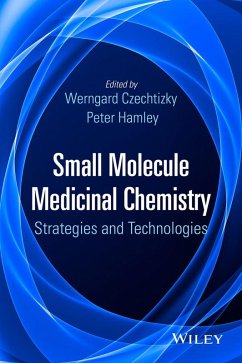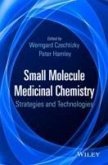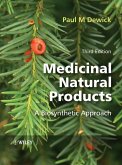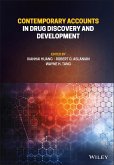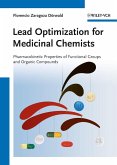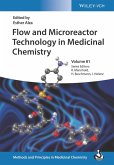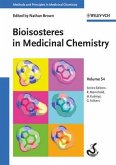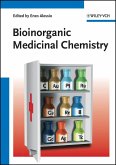Small Molecule Medicinal Chemistry (eBook, ePUB)
Strategies and Technologies
Redaktion: Czechtizky, Werngard; Hamley, Peter
132,99 €
132,99 €
inkl. MwSt.
Sofort per Download lieferbar

0 °P sammeln
132,99 €
Als Download kaufen

132,99 €
inkl. MwSt.
Sofort per Download lieferbar

0 °P sammeln
Jetzt verschenken
Alle Infos zum eBook verschenken
132,99 €
inkl. MwSt.
Sofort per Download lieferbar
Alle Infos zum eBook verschenken

0 °P sammeln
Small Molecule Medicinal Chemistry (eBook, ePUB)
Strategies and Technologies
Redaktion: Czechtizky, Werngard; Hamley, Peter
- Format: ePub
- Merkliste
- Auf die Merkliste
- Bewerten Bewerten
- Teilen
- Produkt teilen
- Produkterinnerung
- Produkterinnerung

Bitte loggen Sie sich zunächst in Ihr Kundenkonto ein oder registrieren Sie sich bei
bücher.de, um das eBook-Abo tolino select nutzen zu können.
Hier können Sie sich einloggen
Hier können Sie sich einloggen
Sie sind bereits eingeloggt. Klicken Sie auf 2. tolino select Abo, um fortzufahren.

Bitte loggen Sie sich zunächst in Ihr Kundenkonto ein oder registrieren Sie sich bei bücher.de, um das eBook-Abo tolino select nutzen zu können.
Stressing strategic and technological solutions to medicinal chemistry challenges, this book presents methods and practices for optimizing the chemical aspects of drug discovery. Chapters discuss benefits, challenges, case studies, and industry perspectives for improving drug discovery programs with respect to quality and costs. . Focuses on small molecules and their critical role in medicinal chemistry, reviewing chemical and economic advantages, challenges, and trends in the field from industry perspectives . Discusses novel approaches and key topics, like screening collection enhancement,…mehr
- Geräte: eReader
- ohne Kopierschutz
- eBook Hilfe
Andere Kunden interessierten sich auch für
![Small Molecule Medicinal Chemistry (eBook, PDF) Small Molecule Medicinal Chemistry (eBook, PDF)]() Small Molecule Medicinal Chemistry (eBook, PDF)132,99 €
Small Molecule Medicinal Chemistry (eBook, PDF)132,99 €![Medicinal Natural Products (eBook, ePUB) Medicinal Natural Products (eBook, ePUB)]() Paul M. DewickMedicinal Natural Products (eBook, ePUB)45,99 €
Paul M. DewickMedicinal Natural Products (eBook, ePUB)45,99 €![Contemporary Accounts in Drug Discovery and Development (eBook, ePUB) Contemporary Accounts in Drug Discovery and Development (eBook, ePUB)]() Contemporary Accounts in Drug Discovery and Development (eBook, ePUB)164,99 €
Contemporary Accounts in Drug Discovery and Development (eBook, ePUB)164,99 €![Lead Optimization for Medicinal Chemists (eBook, ePUB) Lead Optimization for Medicinal Chemists (eBook, ePUB)]() Florencio Zaragoza DörwaldLead Optimization for Medicinal Chemists (eBook, ePUB)156,99 €
Florencio Zaragoza DörwaldLead Optimization for Medicinal Chemists (eBook, ePUB)156,99 €![Flow and Microreactor Technology in Medicinal Chemistry (eBook, ePUB) Flow and Microreactor Technology in Medicinal Chemistry (eBook, ePUB)]() Flow and Microreactor Technology in Medicinal Chemistry (eBook, ePUB)124,99 €
Flow and Microreactor Technology in Medicinal Chemistry (eBook, ePUB)124,99 €![Bioisosteres in Medicinal Chemistry (eBook, ePUB) Bioisosteres in Medicinal Chemistry (eBook, ePUB)]() Bioisosteres in Medicinal Chemistry (eBook, ePUB)144,99 €
Bioisosteres in Medicinal Chemistry (eBook, ePUB)144,99 €![Bioinorganic Medicinal Chemistry (eBook, ePUB) Bioinorganic Medicinal Chemistry (eBook, ePUB)]() Bioinorganic Medicinal Chemistry (eBook, ePUB)165,99 €
Bioinorganic Medicinal Chemistry (eBook, ePUB)165,99 €-
-
-
Stressing strategic and technological solutions to medicinal chemistry challenges, this book presents methods and practices for optimizing the chemical aspects of drug discovery. Chapters discuss benefits, challenges, case studies, and industry perspectives for improving drug discovery programs with respect to quality and costs. . Focuses on small molecules and their critical role in medicinal chemistry, reviewing chemical and economic advantages, challenges, and trends in the field from industry perspectives . Discusses novel approaches and key topics, like screening collection enhancement, risk sharing, HTS triage, new lead finding approaches, diversity-oriented synthesis, peptidomimetics, natural products, and high throughput medicinal chemistry approaches . Explains how to reduce design-make-test cycle times by integrating medicinal chemistry, physical chemistry, and ADME profiling techniques . Includes descriptive case studies, examples, and applications to illustrate new technologies and provide step-by-step explanations to enable them in a laboratory setting
Dieser Download kann aus rechtlichen Gründen nur mit Rechnungsadresse in D ausgeliefert werden.
Produktdetails
- Produktdetails
- Verlag: John Wiley & Sons
- Erscheinungstermin: 25. September 2015
- Englisch
- ISBN-13: 9781118771693
- Artikelnr.: 43973743
- Verlag: John Wiley & Sons
- Erscheinungstermin: 25. September 2015
- Englisch
- ISBN-13: 9781118771693
- Artikelnr.: 43973743
- Herstellerkennzeichnung Die Herstellerinformationen sind derzeit nicht verfügbar.
Werngard Czechtizky is the Head of Medicinal Chemistry of the German Hub of Sanofi, based in Frankfurt, Germany. She has wide experience in lead generation and lead optimization for central nervous system, cardiovascular and diabetes targets, and her teams have been responsible for a number of leads and clinical candidates in these areas over the last years. She was educated at ETH Zürich and Harvard University, USA. Peter Hamley is the global head of External Innovation and Sourcing for chemistry, computational chemistry, and screening technologies at Sanofi, based in Frankfurt, Germany. He spent ten years at AstraZeneca in the United Kingdom, and then moved to Sanofi as a medicinal chemistry leader, building their automated chemistry capabilities and natural product technology. He was educated at Imperial College, London, the University of Cambridge and the University of Pennsylvania.
List of Contributors xiii Introduction 1 Werngard Czechtizky and Peter Hamley Part I Exploring Biological Space: Access to New Collections 11 1 Elements for the Development of Strategies for Compound Library Enhancement 13 Edgar Jacoby 1.1 Introduction 13 1.2 Chemical Space for Drug Discovery 14 1.3 Molecular Properties for Drug Discovery 17 1.4 Major Compound Classes 21 1.5 Chemical Design Approaches to Expand Bioactive Chemical Space 25 1.6 Conclusion 28 Acknowledgments 29 References 29 2 The European Lead Factory 37 Christopher Kallus, Jörg Hüser, Philip S. Jones, and Adam Nelson 2.1 Introduction 37 2.1.1 Background 37 2.1.2 The European Lead Factory 38 2.2 Building the Joint European Compound Library 43 2.2.1 Definition of Criteria and an Approach for the Review and Selection of Library Proposals 46 2.2.2 Collation, Review, and Selection of an Initial Wave of Library Proposals 47 2.2.3 A Web?]Based Tool to Support the Collation, Review, and Selection of Proposals 49 2.2.4 Synthetic Validation of Library Proposals and Library Production 49 2.3 Qualified Hit Generation 54 2.3.1 Capabilities of the ESC 54 2.3.2 Target Selection and Generation of Qualified Hits 56 2.3.3 Exploitation of Qualified Hit List 58 2.4 Future Perspectives 58 Acknowledgments 59 References 59 3 Access to Compound Collections: New Business Models for Compound Acquisition and Sharing 61 Peter ten Holte 3.1 Introduction 61 3.1.1 Vertical Disintegration and the Quest for Innovation 61 3.1.2 Innovative Chemistry 63 3.1.3 Access to Supplementary Compound Collections 63 3.2 Risk?]Sharing Approaches 64 3.2.1 Overview 64 3.2.2 Blinded Screening 65 3.2.3 Follow?]Up of Blinded Screening: Various Models 65 3.3 Library Exchange 69 3.3.1 Partners with Different Scientific Interests 70 3.3.2 Partners with Similar Scientific Interests 70 3.3.3 Compound Selection: Use and Potential Risks 71 3.4 Sharing Collections for External Screening 72 3.4.1 Rationale 72 3.4.2 Academic Drug Discovery Consortium (Addc) 72 3.4.3 Eu?]Openscreen 73 3.4.4 N IH Roadmap 73 3.5 Conclusion 74 Acknowledgments 74 References 75 Part II Exploring Biological Space: Access to New Chemistries 77 4 New Advances in Diversity?]Oriented Synthesis 79 Warren R. J. D. Galloway, Jamie E. Stokes, and David R. Spring 4.1 Introduction: Small Molecules and Biology 79 4.2 The Need for Structural Diversity in Synthetic Small Molecule Screening Collections 80 4.3 Diversity?]Oriented Synthesis of New Structurally Diverse Compound Collections 82 4.3.1 General Principles of Diversity?]Oriented Synthesis 82 4.3.2 Achieving Structural Diversity: The Importance of Scaffold Diversity 83 4.3.3 Synthetic Principles in DOS 83 4.3.4 Scaffold Diversity and Molecular Type 86 4.3.5 Examples of DOS Campaigns 86 4.4 Concluding Remarks 97 References 98 5 Solid?]Phase Combinatorial Chemistry 103 Marcel Patek, Martin Smrcina, Eric Wegrzyniak, Victor Nikolaev, and Andres Mariscal 5.1 Introduction 103 5.2 Chapter Outline 104 5.3 Combinatorial Chemistry in Retrospect 104 5.4 Foundations of Solid?]Phase Synthesis of Combinatorial Chemistry 107 5.4.1 Ingredients of Solid?]Phase Chemistry 109 5.4.2 Library Development and Production 117 5.4.3 Analytical Chemistry and Solid?]Phase Synthesis of Libraries 129 5.5 The Outcome of Tucson Combinatorial Chemistry at Sanofi 132 5.5.1 Overall Strategy 132 5.5.2 Drug Discovery Outcomes 134 5.5.3 Key Parameters of Combichem Productivity 134 5.6 Conclusions and Outlook 135 References 136 6 Recent Advances in Multicomponent Reaction Chemistry: Applications in Small Molecule Drug Discovery 145 Christopher Hulme, Muhammad Ayaz, Guillermo Martinez?]Ariza, Federico Medda, and Arthur Shaw 6.1 Introduction 145 6.2 Classical Multi-Component Reactions (MCRs) 147 6.3 The Passerini Reaction (Mario Passerini 1921) 147 6.4 Ugi Reaction 147 6.4.1 The Ugi-deprotect-cyclize (UDC) strategy 152 6.4.2 Bi-functional approach (BIFA) 153 6.4.3 Miscellaneous Post?]Ugi Condensations 154 6.5 Van Leusen Reaction 154 6.6 Petasis Reaction 155 6.7 Groebke-Blackburn-Bienaymé (GBB) Reaction 155 6.8 Recently Discovered Novel MCRs 155 6.8.1 Cyclic Anhydride?]Based MCRs 155 6.8.2 1?]Azadiene?]Based MCRs 156 6.8.3 Recent IMCRs and Secondary Reactions 157 6.8.4 Miscellaneous MCRs 159 6.9 Asymmetric MCRs 159 6.10 Applications of MCRs in Medicinal Chemistry 160 6.10.1 Kinase Inhibitors 161 6.10.2 Protease Inhibitors 163 6.10.3 Ion Channel Inhibitors 165 6.10.4 Protein-Protein Interaction Inhibitors 165 6.10.5 Tubulin Polymerization Inhibitors 166 6.10.6 G?]Protein?]Coupled Receptors 168 6.11 Summary 171 References 171 Part III Screening Strategies 189 7 Computational Techniques to Support Hit Triage 191 Douglas B. Kitchen and Hélène Y. Decornez 7.1 Lead Finding Process: Overview and Challenges 191 7.1.1 The Need for Triage 191 7.1.2 The Lead Generation Process 191 7.1.3 Hit Triage: From Actives to Hits to Hit Series 193 7.1.4 Challenges to Successful Lead Finding 194 7.1.5 Frequent Hitters 195 7.1.6 Implications of Human Decision?]Making 195 7.2 Chemical Structure Analysis of Hit Lists 196 7.2.1 Similarity?]Based Clustering 197 7.2.2 Scaffold?]Based Clustering 198 7.2.3 Application of Clustering Classification Methods 201 7.3 Rules and Filters 201 7.3.1 Computational Descriptors for Property Assessment 202 7.3.2 Lipophilicity and Other Physicochemical Descriptors 205 7.3.3 Structural and Shape Descriptors 205 7.3.4 Multiparameter Calculations: MPO and QED 206 7.3.5 Frequent?]Hitter Analysis 207 7.3.6 Reactive Group Analysis 209 7.4 Triage Systems 210 7.5 Ligand Efficiency Indices 210 7.6 Hit Series Analysis 211 7.6.1 Latent Hit Series and Singletons 211 7.6.2 Rapid Hit Exploration and Compound Set Enrichment 211 7.6.3 SAR Analysis 212 7.6.4 Data Volume, Integration, Retrieval, and Visualization 213 7.7 Summary 214 References 214 8 Fragment?]Based Drug Discovery 221 Jean?]Paul Renaud, Thomas Neumann, and Luc Van Hijfte 8.1 Introduction 221 8.2 Fragment Libraries 223 8.3 Biophysical Screening Technologies 223 8.3.1 Surface Plasmon Resonance (SPR) 224 8.3.2 Nuclear Magnetic Resonance (NMR) 231 8.3.3 X?]Ray Crystallography 234 8.3.4 Noncovalent Mass Spectrometry 235 8.3.5 Differential Scanning Fluorimetry (DSF) 237 8.3.6 Biophysical Techniques for Fragment Screening against Membrane Proteins 238 8.3.7 Biophysical Techniques for Fragment Screening against PPIs 238 8.4 Fragment Evolution Strategies 239 8.5 Fbdd Case Studies 240 8.5.1 Aurora Kinase Inhibitors 240 8.5.2 Tackling PPIs: Fragment?]Based Discovery of Bromodomain Inhibitor Leads 241 8.6 The Future 243 References 244 9 Virtual Screening 251 Karl?]Heinz Baringhaus and Gerhard Hessler 9.1 Introduction 251 9.1.1 Goals of Virtual Screening 252 9.2 Databases and Database Preparation 254 9.3 Validation of the Virtual Screening Strategy 256 9.4 Ligand?]Based Virtual Screening 258 9.4.1 2D Approaches 259 9.4.2 3D Ligand?]Based Approaches 261 9.5 Structure?]Based Virtual Screening 263 9.6 Other Virtual Screening Applications 266 9.7 Conclusion 268 References 269 10 Phenotypic Screening 281 Michelle Palmer 10.1 Introduction 281 10.2 History and Past Successes 282 10.3 Impact of Phenotypic Screening 282 10.4 Model Systems for Phenotypic Assays 285 10.4.1 Cell Lines 285 10.4.2 Primary and Stem Cells 285 10.4.3 Cocultures 286 10.4.4 3D Cell Models 287 10.5 Assays 287 10.5.1 Assay Technologies 287 10.5.2 Assay Development Considerations 290 10.5.3 Example 1: Selective Killing of Breast Cancer Stem Cells 291 10.5.4 Example 2: CFTR Potentiator Drug 291 10.6 Deorphaning 292 10.6.1 Affinity?]Based Proteomics 292 10.6.2 Genetic Profiling 295 10.6.3 Target Profiling 296 10.6.4 Comodifier Profiling 296 10.6.5 Target Engagement 297 10.6.6 Example 3: Elucidating MOA for a Regulator of Polyploidization 297 10.7 Summary 298 References 299 Part IV Technologies for Medicinal Chemistry Optimization 305 11 Advances in the Understanding of Drug Properties in Medicinal Chemistry 307 Peter Hamley and Patrick Jimonet 11.1 Introduction 307 11.2 Properties and Origins of Marketed Drugs 308 11.2.1 The Consistent Properties of Oral Drugs 308 11.2.2 The Changing Origins of Oral Drugs 308 11.3 Drug Properties and Attrition in Clinical Development 310 11.4 The Rule of Five 312 11.4.1 The Concept 312 11.4.2 Druggability 313 11.5 The Concept of Lead?]Likeness 313 11.5.1 The Consequences on Screening and Collections 314 11.6 Influence of Drug Properties on Absorption, Distribution, Metabolism, Excretion, and Toxicity 314 11.7 Building on the Ro5: New Guidelines for Compound Design 316 11.7.1 Ligand Efficiency 316 11.7.2 Ligand Lipophilicity Efficiency and Other Indices 317 11.7.3 Chemical Beauty 318 11.8 Alternatives, Criticisms, and Exceptions 318 11.9 Conclusions 320 References 320 12 Recent Developments in Automated Solution Phase Library Production 323 Thomas C. Maier and Werngard Czechtizky 12.1 Introduction 323 12.1.1 Introduction and Definitions 323 12.1.2 Library Types 324 12.1.3 Chemotypes 326 12.2 Library Production 327 12.2.1 The Library Production Process 327 12.2.2 Process Optimization 330 12.3 New Technologies in Automated Liquid?]Phase Library Synthesis 334 12.3.1 Provision of Starting Materials: Automated Reagent Dispensaries 334 12.3.2 Microwave 335 12.3.3 Library Purification: Automated RP?]HPLC and SFC as Orthogonal Methods 336 12.4 Flow Chemistry and Gas?]Phase Reactions 342 12.4.1 Reactive Gases in Flow 344 12.5 Conclusion 345 References 345 13 A DME Profiling: An Introduction for the Medicinal Chemist 353 Katharina Mertsch, Martin Will, Werngard Czechtizky, Niels Griesang, Alexander Marker, and Jacob Olsen 13.1 Introduction 353 13.2 Compound Profiling in H2L Optimization 354 13.2.1 Intestinal Absorption 354 13.2.2 Drug Metabolism and Inhibition of CYP450 Enzymes 355 13.2.3 Protein Binding 356 13.2.4 En Route to a Lead Series: In Vivo PK Studies 358 13.3 Compound Profiling in Lead Optimization 359 13.3.1 Extended CYP Inhibition Studies 359 13.3.2 Mechanism?]Based CYP Inhibition 359 13.3.3 Inhibition of Transport Proteins 360 13.3.4 Biopharmaceutical Classification of a Clinical Candidate (Classification of Potential Drugs into Biopharmaceutical Classification System or Biopharmaceutical Drug Disposition and Classification System) 360 13.4 Integration of Medicinal Chemistry, Biology, Physicochemical, and ADME Profiling: Strategies Toward Cycle Time Reductions 362 13.4.1 Planning Phase 363 13.4.2 Sample Preparation and Distribution 364 13.4.3 Compound QC 365 13.4.4 Determination of Physicochemical Properties 367 13.4.5 ADME Profiling: General Remarks 369 13.4.6 Metabolic Lability Profiling 369 13.4.7 Permeability Testing 370 13.4.8 CYP Inhibition Profiling 372 13.5 Summary 372 References 373 Part V Medicinal Chemistry beyond Small Molecules 379 14 The Role of Natural Products in Drug Discovery: Examples of Marketed Drugs 381 Lars Ole Haustedt and Karsten Siems 14.1 Natural Products and Natural Product Derivatives in Commercial Drugs 381 14.2 Hit to Lead Optimization of Natural Product Hits 397 14.3 Case Study 1: Taxol 397 14.4 Case Study 2: Epothilone 406 14.5 Case Study 3: Eribulin 407 14.6 Case Study 4: Geldanamycin 413 14.7 Case Study 5: Ingenol Mebutate (Picato) 417 14.8 Summary 422 References 423 15 Peptidomimetics of
?]Helical and ß?]Strand Protein Binding Epitopes 431 Nina Bionda and Rudi Fasan 15.1 Protein-Protein Interactions as Therapeutic Targets 431 15.2 Peptidomimetics of
?]Helical Protein Binding Epitopes 433 15.2.1
?]Helix?]Mediated PPIs 433 15.2.2 Side?]Chain Cross?]Linked
?]Helices 435 15.2.3 Hydrogen?]Bond Surrogate?]Stabilized
?]Helices 442 15.2.4 Other Type I
?]Helix Peptidomimetics 443 15.2.5 Type III
?]Helix Peptidomimetics 445 15.3 Peptidomimetics of ß?]Strand Protein Binding Epitopes 446 15.3.1 ß?]Strand?]Mediated PPIs 446 15.3.2 Type I ß?]Strand Peptidomimetics 447 15.3.3 Type III ß?]Strand Peptidomimetics 449 15.4 Conclusion 452 References 453 16 In Vivo Imaging of Drug Action 465 Oliver Plettenburg and Matthias Löhn 16.1 Introduction 465 16.2 Overview of Imaging Methods 466 16.2.1 Fluorescence?]Based Methods 466 16.2.2 MRI 470 16.2.3 CT 470 16.2.4 PET/SPECT 471 16.3 Imaging of Therapeutic Effects 476 16.3.1 Cancer 476 16.3.2 Diabetes 483 16.3.3 CNS Disorders 486 16.4 Conclusion and Outlook 490 References 491 Index 503
?]Helical and ß?]Strand Protein Binding Epitopes 431 Nina Bionda and Rudi Fasan 15.1 Protein-Protein Interactions as Therapeutic Targets 431 15.2 Peptidomimetics of
?]Helical Protein Binding Epitopes 433 15.2.1
?]Helix?]Mediated PPIs 433 15.2.2 Side?]Chain Cross?]Linked
?]Helices 435 15.2.3 Hydrogen?]Bond Surrogate?]Stabilized
?]Helices 442 15.2.4 Other Type I
?]Helix Peptidomimetics 443 15.2.5 Type III
?]Helix Peptidomimetics 445 15.3 Peptidomimetics of ß?]Strand Protein Binding Epitopes 446 15.3.1 ß?]Strand?]Mediated PPIs 446 15.3.2 Type I ß?]Strand Peptidomimetics 447 15.3.3 Type III ß?]Strand Peptidomimetics 449 15.4 Conclusion 452 References 453 16 In Vivo Imaging of Drug Action 465 Oliver Plettenburg and Matthias Löhn 16.1 Introduction 465 16.2 Overview of Imaging Methods 466 16.2.1 Fluorescence?]Based Methods 466 16.2.2 MRI 470 16.2.3 CT 470 16.2.4 PET/SPECT 471 16.3 Imaging of Therapeutic Effects 476 16.3.1 Cancer 476 16.3.2 Diabetes 483 16.3.3 CNS Disorders 486 16.4 Conclusion and Outlook 490 References 491 Index 503
List of Contributors xiii Introduction 1 Werngard Czechtizky and Peter Hamley Part I Exploring Biological Space: Access to New Collections 11 1 Elements for the Development of Strategies for Compound Library Enhancement 13 Edgar Jacoby 1.1 Introduction 13 1.2 Chemical Space for Drug Discovery 14 1.3 Molecular Properties for Drug Discovery 17 1.4 Major Compound Classes 21 1.5 Chemical Design Approaches to Expand Bioactive Chemical Space 25 1.6 Conclusion 28 Acknowledgments 29 References 29 2 The European Lead Factory 37 Christopher Kallus, Jörg Hüser, Philip S. Jones, and Adam Nelson 2.1 Introduction 37 2.1.1 Background 37 2.1.2 The European Lead Factory 38 2.2 Building the Joint European Compound Library 43 2.2.1 Definition of Criteria and an Approach for the Review and Selection of Library Proposals 46 2.2.2 Collation, Review, and Selection of an Initial Wave of Library Proposals 47 2.2.3 A Web?]Based Tool to Support the Collation, Review, and Selection of Proposals 49 2.2.4 Synthetic Validation of Library Proposals and Library Production 49 2.3 Qualified Hit Generation 54 2.3.1 Capabilities of the ESC 54 2.3.2 Target Selection and Generation of Qualified Hits 56 2.3.3 Exploitation of Qualified Hit List 58 2.4 Future Perspectives 58 Acknowledgments 59 References 59 3 Access to Compound Collections: New Business Models for Compound Acquisition and Sharing 61 Peter ten Holte 3.1 Introduction 61 3.1.1 Vertical Disintegration and the Quest for Innovation 61 3.1.2 Innovative Chemistry 63 3.1.3 Access to Supplementary Compound Collections 63 3.2 Risk?]Sharing Approaches 64 3.2.1 Overview 64 3.2.2 Blinded Screening 65 3.2.3 Follow?]Up of Blinded Screening: Various Models 65 3.3 Library Exchange 69 3.3.1 Partners with Different Scientific Interests 70 3.3.2 Partners with Similar Scientific Interests 70 3.3.3 Compound Selection: Use and Potential Risks 71 3.4 Sharing Collections for External Screening 72 3.4.1 Rationale 72 3.4.2 Academic Drug Discovery Consortium (Addc) 72 3.4.3 Eu?]Openscreen 73 3.4.4 N IH Roadmap 73 3.5 Conclusion 74 Acknowledgments 74 References 75 Part II Exploring Biological Space: Access to New Chemistries 77 4 New Advances in Diversity?]Oriented Synthesis 79 Warren R. J. D. Galloway, Jamie E. Stokes, and David R. Spring 4.1 Introduction: Small Molecules and Biology 79 4.2 The Need for Structural Diversity in Synthetic Small Molecule Screening Collections 80 4.3 Diversity?]Oriented Synthesis of New Structurally Diverse Compound Collections 82 4.3.1 General Principles of Diversity?]Oriented Synthesis 82 4.3.2 Achieving Structural Diversity: The Importance of Scaffold Diversity 83 4.3.3 Synthetic Principles in DOS 83 4.3.4 Scaffold Diversity and Molecular Type 86 4.3.5 Examples of DOS Campaigns 86 4.4 Concluding Remarks 97 References 98 5 Solid?]Phase Combinatorial Chemistry 103 Marcel Patek, Martin Smrcina, Eric Wegrzyniak, Victor Nikolaev, and Andres Mariscal 5.1 Introduction 103 5.2 Chapter Outline 104 5.3 Combinatorial Chemistry in Retrospect 104 5.4 Foundations of Solid?]Phase Synthesis of Combinatorial Chemistry 107 5.4.1 Ingredients of Solid?]Phase Chemistry 109 5.4.2 Library Development and Production 117 5.4.3 Analytical Chemistry and Solid?]Phase Synthesis of Libraries 129 5.5 The Outcome of Tucson Combinatorial Chemistry at Sanofi 132 5.5.1 Overall Strategy 132 5.5.2 Drug Discovery Outcomes 134 5.5.3 Key Parameters of Combichem Productivity 134 5.6 Conclusions and Outlook 135 References 136 6 Recent Advances in Multicomponent Reaction Chemistry: Applications in Small Molecule Drug Discovery 145 Christopher Hulme, Muhammad Ayaz, Guillermo Martinez?]Ariza, Federico Medda, and Arthur Shaw 6.1 Introduction 145 6.2 Classical Multi-Component Reactions (MCRs) 147 6.3 The Passerini Reaction (Mario Passerini 1921) 147 6.4 Ugi Reaction 147 6.4.1 The Ugi-deprotect-cyclize (UDC) strategy 152 6.4.2 Bi-functional approach (BIFA) 153 6.4.3 Miscellaneous Post?]Ugi Condensations 154 6.5 Van Leusen Reaction 154 6.6 Petasis Reaction 155 6.7 Groebke-Blackburn-Bienaymé (GBB) Reaction 155 6.8 Recently Discovered Novel MCRs 155 6.8.1 Cyclic Anhydride?]Based MCRs 155 6.8.2 1?]Azadiene?]Based MCRs 156 6.8.3 Recent IMCRs and Secondary Reactions 157 6.8.4 Miscellaneous MCRs 159 6.9 Asymmetric MCRs 159 6.10 Applications of MCRs in Medicinal Chemistry 160 6.10.1 Kinase Inhibitors 161 6.10.2 Protease Inhibitors 163 6.10.3 Ion Channel Inhibitors 165 6.10.4 Protein-Protein Interaction Inhibitors 165 6.10.5 Tubulin Polymerization Inhibitors 166 6.10.6 G?]Protein?]Coupled Receptors 168 6.11 Summary 171 References 171 Part III Screening Strategies 189 7 Computational Techniques to Support Hit Triage 191 Douglas B. Kitchen and Hélène Y. Decornez 7.1 Lead Finding Process: Overview and Challenges 191 7.1.1 The Need for Triage 191 7.1.2 The Lead Generation Process 191 7.1.3 Hit Triage: From Actives to Hits to Hit Series 193 7.1.4 Challenges to Successful Lead Finding 194 7.1.5 Frequent Hitters 195 7.1.6 Implications of Human Decision?]Making 195 7.2 Chemical Structure Analysis of Hit Lists 196 7.2.1 Similarity?]Based Clustering 197 7.2.2 Scaffold?]Based Clustering 198 7.2.3 Application of Clustering Classification Methods 201 7.3 Rules and Filters 201 7.3.1 Computational Descriptors for Property Assessment 202 7.3.2 Lipophilicity and Other Physicochemical Descriptors 205 7.3.3 Structural and Shape Descriptors 205 7.3.4 Multiparameter Calculations: MPO and QED 206 7.3.5 Frequent?]Hitter Analysis 207 7.3.6 Reactive Group Analysis 209 7.4 Triage Systems 210 7.5 Ligand Efficiency Indices 210 7.6 Hit Series Analysis 211 7.6.1 Latent Hit Series and Singletons 211 7.6.2 Rapid Hit Exploration and Compound Set Enrichment 211 7.6.3 SAR Analysis 212 7.6.4 Data Volume, Integration, Retrieval, and Visualization 213 7.7 Summary 214 References 214 8 Fragment?]Based Drug Discovery 221 Jean?]Paul Renaud, Thomas Neumann, and Luc Van Hijfte 8.1 Introduction 221 8.2 Fragment Libraries 223 8.3 Biophysical Screening Technologies 223 8.3.1 Surface Plasmon Resonance (SPR) 224 8.3.2 Nuclear Magnetic Resonance (NMR) 231 8.3.3 X?]Ray Crystallography 234 8.3.4 Noncovalent Mass Spectrometry 235 8.3.5 Differential Scanning Fluorimetry (DSF) 237 8.3.6 Biophysical Techniques for Fragment Screening against Membrane Proteins 238 8.3.7 Biophysical Techniques for Fragment Screening against PPIs 238 8.4 Fragment Evolution Strategies 239 8.5 Fbdd Case Studies 240 8.5.1 Aurora Kinase Inhibitors 240 8.5.2 Tackling PPIs: Fragment?]Based Discovery of Bromodomain Inhibitor Leads 241 8.6 The Future 243 References 244 9 Virtual Screening 251 Karl?]Heinz Baringhaus and Gerhard Hessler 9.1 Introduction 251 9.1.1 Goals of Virtual Screening 252 9.2 Databases and Database Preparation 254 9.3 Validation of the Virtual Screening Strategy 256 9.4 Ligand?]Based Virtual Screening 258 9.4.1 2D Approaches 259 9.4.2 3D Ligand?]Based Approaches 261 9.5 Structure?]Based Virtual Screening 263 9.6 Other Virtual Screening Applications 266 9.7 Conclusion 268 References 269 10 Phenotypic Screening 281 Michelle Palmer 10.1 Introduction 281 10.2 History and Past Successes 282 10.3 Impact of Phenotypic Screening 282 10.4 Model Systems for Phenotypic Assays 285 10.4.1 Cell Lines 285 10.4.2 Primary and Stem Cells 285 10.4.3 Cocultures 286 10.4.4 3D Cell Models 287 10.5 Assays 287 10.5.1 Assay Technologies 287 10.5.2 Assay Development Considerations 290 10.5.3 Example 1: Selective Killing of Breast Cancer Stem Cells 291 10.5.4 Example 2: CFTR Potentiator Drug 291 10.6 Deorphaning 292 10.6.1 Affinity?]Based Proteomics 292 10.6.2 Genetic Profiling 295 10.6.3 Target Profiling 296 10.6.4 Comodifier Profiling 296 10.6.5 Target Engagement 297 10.6.6 Example 3: Elucidating MOA for a Regulator of Polyploidization 297 10.7 Summary 298 References 299 Part IV Technologies for Medicinal Chemistry Optimization 305 11 Advances in the Understanding of Drug Properties in Medicinal Chemistry 307 Peter Hamley and Patrick Jimonet 11.1 Introduction 307 11.2 Properties and Origins of Marketed Drugs 308 11.2.1 The Consistent Properties of Oral Drugs 308 11.2.2 The Changing Origins of Oral Drugs 308 11.3 Drug Properties and Attrition in Clinical Development 310 11.4 The Rule of Five 312 11.4.1 The Concept 312 11.4.2 Druggability 313 11.5 The Concept of Lead?]Likeness 313 11.5.1 The Consequences on Screening and Collections 314 11.6 Influence of Drug Properties on Absorption, Distribution, Metabolism, Excretion, and Toxicity 314 11.7 Building on the Ro5: New Guidelines for Compound Design 316 11.7.1 Ligand Efficiency 316 11.7.2 Ligand Lipophilicity Efficiency and Other Indices 317 11.7.3 Chemical Beauty 318 11.8 Alternatives, Criticisms, and Exceptions 318 11.9 Conclusions 320 References 320 12 Recent Developments in Automated Solution Phase Library Production 323 Thomas C. Maier and Werngard Czechtizky 12.1 Introduction 323 12.1.1 Introduction and Definitions 323 12.1.2 Library Types 324 12.1.3 Chemotypes 326 12.2 Library Production 327 12.2.1 The Library Production Process 327 12.2.2 Process Optimization 330 12.3 New Technologies in Automated Liquid?]Phase Library Synthesis 334 12.3.1 Provision of Starting Materials: Automated Reagent Dispensaries 334 12.3.2 Microwave 335 12.3.3 Library Purification: Automated RP?]HPLC and SFC as Orthogonal Methods 336 12.4 Flow Chemistry and Gas?]Phase Reactions 342 12.4.1 Reactive Gases in Flow 344 12.5 Conclusion 345 References 345 13 A DME Profiling: An Introduction for the Medicinal Chemist 353 Katharina Mertsch, Martin Will, Werngard Czechtizky, Niels Griesang, Alexander Marker, and Jacob Olsen 13.1 Introduction 353 13.2 Compound Profiling in H2L Optimization 354 13.2.1 Intestinal Absorption 354 13.2.2 Drug Metabolism and Inhibition of CYP450 Enzymes 355 13.2.3 Protein Binding 356 13.2.4 En Route to a Lead Series: In Vivo PK Studies 358 13.3 Compound Profiling in Lead Optimization 359 13.3.1 Extended CYP Inhibition Studies 359 13.3.2 Mechanism?]Based CYP Inhibition 359 13.3.3 Inhibition of Transport Proteins 360 13.3.4 Biopharmaceutical Classification of a Clinical Candidate (Classification of Potential Drugs into Biopharmaceutical Classification System or Biopharmaceutical Drug Disposition and Classification System) 360 13.4 Integration of Medicinal Chemistry, Biology, Physicochemical, and ADME Profiling: Strategies Toward Cycle Time Reductions 362 13.4.1 Planning Phase 363 13.4.2 Sample Preparation and Distribution 364 13.4.3 Compound QC 365 13.4.4 Determination of Physicochemical Properties 367 13.4.5 ADME Profiling: General Remarks 369 13.4.6 Metabolic Lability Profiling 369 13.4.7 Permeability Testing 370 13.4.8 CYP Inhibition Profiling 372 13.5 Summary 372 References 373 Part V Medicinal Chemistry beyond Small Molecules 379 14 The Role of Natural Products in Drug Discovery: Examples of Marketed Drugs 381 Lars Ole Haustedt and Karsten Siems 14.1 Natural Products and Natural Product Derivatives in Commercial Drugs 381 14.2 Hit to Lead Optimization of Natural Product Hits 397 14.3 Case Study 1: Taxol 397 14.4 Case Study 2: Epothilone 406 14.5 Case Study 3: Eribulin 407 14.6 Case Study 4: Geldanamycin 413 14.7 Case Study 5: Ingenol Mebutate (Picato) 417 14.8 Summary 422 References 423 15 Peptidomimetics of
?]Helical and ß?]Strand Protein Binding Epitopes 431 Nina Bionda and Rudi Fasan 15.1 Protein-Protein Interactions as Therapeutic Targets 431 15.2 Peptidomimetics of
?]Helical Protein Binding Epitopes 433 15.2.1
?]Helix?]Mediated PPIs 433 15.2.2 Side?]Chain Cross?]Linked
?]Helices 435 15.2.3 Hydrogen?]Bond Surrogate?]Stabilized
?]Helices 442 15.2.4 Other Type I
?]Helix Peptidomimetics 443 15.2.5 Type III
?]Helix Peptidomimetics 445 15.3 Peptidomimetics of ß?]Strand Protein Binding Epitopes 446 15.3.1 ß?]Strand?]Mediated PPIs 446 15.3.2 Type I ß?]Strand Peptidomimetics 447 15.3.3 Type III ß?]Strand Peptidomimetics 449 15.4 Conclusion 452 References 453 16 In Vivo Imaging of Drug Action 465 Oliver Plettenburg and Matthias Löhn 16.1 Introduction 465 16.2 Overview of Imaging Methods 466 16.2.1 Fluorescence?]Based Methods 466 16.2.2 MRI 470 16.2.3 CT 470 16.2.4 PET/SPECT 471 16.3 Imaging of Therapeutic Effects 476 16.3.1 Cancer 476 16.3.2 Diabetes 483 16.3.3 CNS Disorders 486 16.4 Conclusion and Outlook 490 References 491 Index 503
?]Helical and ß?]Strand Protein Binding Epitopes 431 Nina Bionda and Rudi Fasan 15.1 Protein-Protein Interactions as Therapeutic Targets 431 15.2 Peptidomimetics of
?]Helical Protein Binding Epitopes 433 15.2.1
?]Helix?]Mediated PPIs 433 15.2.2 Side?]Chain Cross?]Linked
?]Helices 435 15.2.3 Hydrogen?]Bond Surrogate?]Stabilized
?]Helices 442 15.2.4 Other Type I
?]Helix Peptidomimetics 443 15.2.5 Type III
?]Helix Peptidomimetics 445 15.3 Peptidomimetics of ß?]Strand Protein Binding Epitopes 446 15.3.1 ß?]Strand?]Mediated PPIs 446 15.3.2 Type I ß?]Strand Peptidomimetics 447 15.3.3 Type III ß?]Strand Peptidomimetics 449 15.4 Conclusion 452 References 453 16 In Vivo Imaging of Drug Action 465 Oliver Plettenburg and Matthias Löhn 16.1 Introduction 465 16.2 Overview of Imaging Methods 466 16.2.1 Fluorescence?]Based Methods 466 16.2.2 MRI 470 16.2.3 CT 470 16.2.4 PET/SPECT 471 16.3 Imaging of Therapeutic Effects 476 16.3.1 Cancer 476 16.3.2 Diabetes 483 16.3.3 CNS Disorders 486 16.4 Conclusion and Outlook 490 References 491 Index 503
